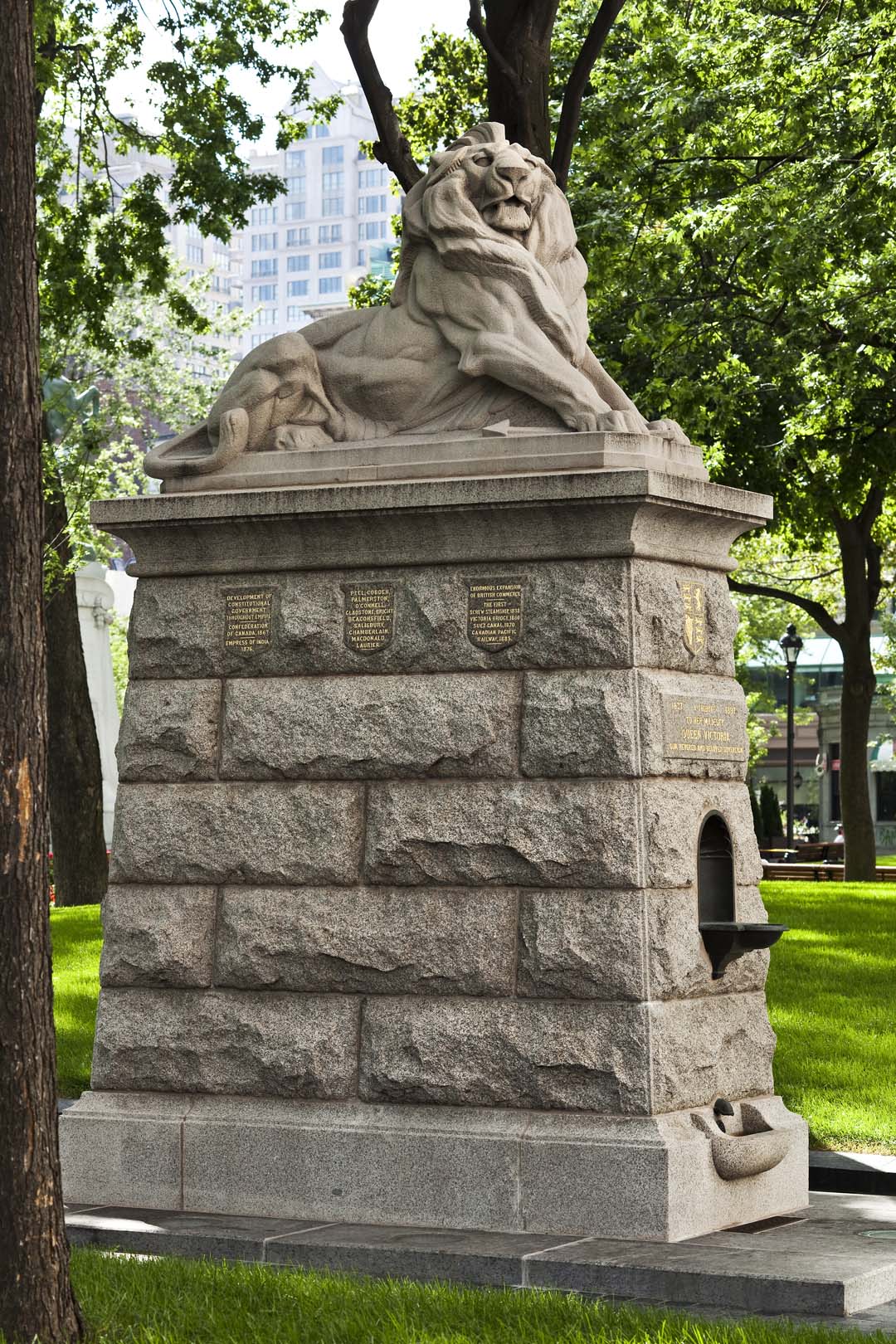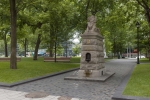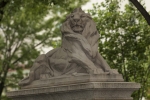George William Hill
Le lion de Belfort
1897
Presentation of the artwork
This pink-granite fountain-monument is composed of a pedestal, with a lion lying on top of it. On the pedestal are engraved escutcheons celebrating events, inventions, and individuals who marked the reign of Queen Victoria: the first world’s fair, the telephone, the electric light bulb, Dickens, Darwin, and so on. A drinking fountain is also imbedded in the pedestal; the current fountain was reconstructed in 2009 on the model of the original fountain.The lion symbolizes British strength and protection. This is a copy, at a scale of about 1:10, of the French sculptor August Bartholdi’s Lion de Belfort. The original artwork overlooks the Belfort citadel and measures 22 m in length and 11 m in height. Produced between 1875 and 1880, it is carved from the site’s red sandstone. The Montréal lion was George William Hill’s first public commission. The pedestal was designed by the architect Robert Findlay.
Associated events
Donated to the Ville de Montréal by the Sun Life Insurance Company on the occasion of Queen Victoria’s Diamond Jubilee, the artwork was initially installed in Dorchester Square, near Boulevard René-Lévesque (then Dorchester Boulevard). In 1953, it had to make way for the Monument to Sir Wilfrid Laurier and was moved to within Dorchester Square, facing the Sun Life building on Rue Metcalfe.
Queen Victoria’s reign lasted almost 63 years and remains the longest in the history of the United Kingdom. It was marked by great expansion of the British Empire and the industrial revolution. The period of her reign is also called the Victorian era.
George William Hill
George William Hill was born in Shipton, Eastern Townships, in 1861. He learned to carve marble in his father’s company, after he graduated from college. Between 1889 and 1894, he left Québec to study sculpting at the École nationale des beaux-arts and Académie Julian in Paris. When he returned to Montréal, he opened a studio and worked with the architect Robert Findlay and brothers Edward and William S. Maxwell. Known for his public monuments and war memorials, he is now considered one of the most important Canadian sculptors of the early twentieth century. The National Gallery of Canada, the Musée du Québec, and the Montréal Museum of Fine Art have artworks by him in their collections.
Presentation of the artwork
This pink-granite fountain-monument is composed of a pedestal, with a lion lying on top of it. On the pedestal are engraved escutcheons celebrating events, inventions, and individuals who marked the reign of Queen Victoria: the first world’s fair, the telephone, the electric light bulb, Dickens, Darwin, and so on. A drinking fountain is also imbedded in the pedestal; the current fountain was reconstructed in 2009 on the model of the original fountain.The lion symbolizes British strength and protection. This is a copy, at a scale of about 1:10, of the French sculptor August Bartholdi’s Lion de Belfort. The original artwork overlooks the Belfort citadel and measures 22 m in length and 11 m in height. Produced between 1875 and 1880, it is carved from the site’s red sandstone. The Montréal lion was George William Hill’s first public commission. The pedestal was designed by the architect Robert Findlay.
Associated events
Donated to the Ville de Montréal by the Sun Life Insurance Company on the occasion of Queen Victoria’s Diamond Jubilee, the artwork was initially installed in Dorchester Square, near Boulevard René-Lévesque (then Dorchester Boulevard). In 1953, it had to make way for the Monument to Sir Wilfrid Laurier and was moved to within Dorchester Square, facing the Sun Life building on Rue Metcalfe.
Queen Victoria’s reign lasted almost 63 years and remains the longest in the history of the United Kingdom. It was marked by great expansion of the British Empire and the industrial revolution. The period of her reign is also called the Victorian era.
George William Hill
George William Hill was born in Shipton, Eastern Townships, in 1861. He learned to carve marble in his father’s company, after he graduated from college. Between 1889 and 1894, he left Québec to study sculpting at the École nationale des beaux-arts and Académie Julian in Paris. When he returned to Montréal, he opened a studio and worked with the architect Robert Findlay and brothers Edward and William S. Maxwell. Known for his public monuments and war memorials, he is now considered one of the most important Canadian sculptors of the early twentieth century. The National Gallery of Canada, the Musée du Québec, and the Montréal Museum of Fine Art have artworks by him in their collections.






